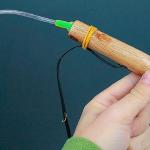A functioning bathroom is what is required for a comfortable stay in a house or apartment.
It is extremely frustrating when the toilet breaks. If the water is constantly leaking, it is also expensive. Payment for water is by meter.
It is not always possible to replace a product.
In the case of a mechanical control system, the toilet cistern can be repaired independently. Before troubleshooting, you should decide on the type of drain and identify the cause of the breakdown.
Kinds
drain cisterns
The devices differ in several design details.

Drain mechanisms
- Lever. It is installed in separate products, where the tank can be located both above and below. Water is drained into the toilet bowl when the lever is actuated.
- Pneumatic. Water is drained after pressing the button of the pneumatic chamber.
- stock. The rod rises, the mechanism frees the passage for the liquid. The stem is always displayed on the tank cover.
- Button. The drain mechanism works by pressing a button, which is located on the tank lid. Models with two flush buttons are available. When one button is pressed, half of the liquid descends, when another button is pressed, the entire drive is drained.
The storage tank is filled with liquid to the required level, after which the water supply automatically stops.
valves
The type of valve depends on how the water is supplied to the tank.
Systems without a float are lower and side.
Such structures are equipped with a special camera. The system works according to the law of Archimedes. The tank is filled with water and the location of the chamber is changed, which stops the flow of liquid.
The side valve with a float is manufactured in two versions - diaphragm and piston. In each option, filling the tank stops when a certain amount of water is collected.
The drain mechanism may consist of interchangeable parts or be a single set.
Connection type
- Side. The tank has two openings on each side. A flexible hose is brought to one of the walls, a plug is placed on the second hole. The disadvantages of such an eyeliner are excessive noise when collecting water and the lack of aesthetics.
- Bottom type of eyeliner. The hose for a set of liquid is mounted in the bottom of the tank. Filling is almost silent.
One model can be produced with two types of connection. Three mechanisms that are present in each tank.
- shut-off or drain mechanism. Regulates drain, controls overflow.
- Bulk valve. The valve for filling the tank can be located both on the side and below. The float is always on top.
- Drain device and overflow.
The main breakdowns of the toilet tank are always associated with these three devices.
For your information. Mechanical damage to the tank itself (cracks or chips) cannot be repaired. The product will need to be replaced.
Drain tank malfunctions
Water from the tank flows to the floor
If dampness or a puddle of clean water appears behind the toilet bowl, this indicates that the gasket installed between the tank and the toilet bowl has become unusable and must be replaced.
To make a replacement, you will first need to purchase an o-ring. Then follow the instructions to fix the problem.
- Shut off the water supply to the toilet.
- Drain water from tank
- Disconnect the water supply hose
- Release the tank from the lid
- Dismantle the drain tank
- Replace gasket
- Reassemble in reverse order.
Waterproof silicone can be used to increase sealing.
No water is delivered to the tank
This error has several causes.

As soon as the water began to flow freely, we set the valve, the valve with the lever and the float to its original position. Sometimes cleaning the valve fails, in which case it should be replaced.
Water constantly leaks into the bowl
- The reason is the incorrect operation of the float. It does not stop the flow of liquid, and it constantly flows through the overflow.
- Lever changed position to inoperable
- Broken water supply valve
If the design of the tank of the Soviet era, you should start to identify the malfunction from the float. Perhaps it burst, water flowed into it and it can no longer rise and stop the water supply. If this is the reason, the part must be replaced.
In modern toilets, a drain column is installed, there is no float in them. This part is not repairable, just replaced with a new one.
Water may leak due to a broken inlet valve.
- Check the lever next to the valve for mechanical damage.
- We release the tank, we look at how water is collected
- Move the lever. He closes the valve. If there is a bend, straighten the lever.
- The lever does not move. A jam has occurred. We are replacing the node.
A failure of the inlet valve itself implies its replacement. The part is dismantled, a similar one is bought in the store and installed in the system.
Broken internal fittings
Sometimes there are several faults at the same time. The entire drain system should be replaced.
Replacing the drain mechanism with a lower set of water.
- Close the tap to supply water to the tank, free it from the liquid.
- We remove the cover.
- Unscrew the flexible hose
- Turn the top of the column and remove
- We dismantle the tank by first unscrewing the retaining bolts
- Dismantle the inlet valve and drain button
- We take out the old mechanism
- Installing new fittings.
- We put the tank in its original position.
Loud noise when filling water
This fact is not a defect. Noisy tanks with a top supply.
Models are available where you can adjust the diameter of the hole. It won't completely eliminate noise, but it will reduce its level.
In cases where it is not possible to make adjustments, there is a modification option.
A rubber tube with an inlet diameter up to 30 cm long is taken.
The tube is put on the inlet, fixed, the end is lowered to the bottom of the tank.
This eliminates the fall of water from a height, filling starts from the bottom, respectively, the noise disappears.
Sticky button or two buttons
The toilet model with two flush buttons is in demand. In such a product, sticking of buttons sometimes occurs. To make repairs, you need to remove the cover.
First, the nuts holding the buttons are unscrewed, after which you can open the tank. Pressing the buttons at the same time sometimes helps them fall into place.
If the manipulation did not work, you should check the button shaft. Sometimes she gets dirty. After cleaning the shaft, repeat the check. If there is no result, a new part must be installed.
The node is dismantled, purchased exactly the same and installed.
Results
In the event of a malfunction, it is far from always necessary to buy a new product; it is often very easy to repair it yourself.
For a comfortable stay of a person, water supply and lighting of the room are necessary, as well as properly working plumbing devices connected to the sewer system. One of the most popular plumbing fixtures are the toilet and cistern. Currently, cisterns are most often equipped with buttons that are responsible for the smooth descent of water into the toilet. The toilet bowl button becomes unusable over time or requires repair. How to do this, read on.
Tank device with a button
The drain tank is a container that stores water for draining. For operation, the tank is equipped with elements. Toilet cistern device with button:
- drain mechanism. The device connected to the button is responsible for draining the water. In the lower part, the drain mechanism is equipped with a sealed membrane that protects against the formation of water leakage into the toilet bowl;

The drain mechanism can be equipped with:
- single button. Descent of water occurs at the touch of a button. In this case, all the liquid from the tank enters the toilet;

- dual mode button. The button with several modes of operation is divided into two parts: small and large. When using a smaller part, half of the liquid in the tank gets into the toilet. When the water is drained by the greater part of the button, the water is drained completely.

Using a button with two operating modes allows you to save cold water.
- filling valve responsible for the collection of water in the tank. The filling mechanism is equipped with a float that regulates the level of water in the tank. The mechanism may have:
- lateral water supply. Most often found in Russian-made cisterns. A distinctive feature of the mechanism is the formation of noise when collecting water;

- bottom water supply. When installing a valve with a bottom connection, it is important to achieve complete tightness of the connection.

All fittings installed in are interconnected. After pressing the button, the water is drained. In this case, the float of the filling valve sinks to the bottom of the tank and opens the inlet valve. Water begins to flow from the water supply and raise the float to the set level. When the container is full, the inlet valve will be automatically closed.

Button repair
The fittings of the tank may become unusable for the following reasons:
- use of low-quality mechanisms. Professional plumbers recommend installing cistern fittings made by companies such as Cersanit, Vidima, Jika;
- natural wear. Any device is designed for a certain number of years of use or number of flush cycles;
- mechanical damage. Careless use may cause damage.
Button malfunctions and solutions
The most common button failures are:
- "sticking" of the button, that is, the flushing of water occurs only after repeatedly pressing the descender;
- failure of the button, that is, the button mechanism descends into the capacity of the drain tank.
Elimination of sticking
If the water is flushed after repeatedly pressing the button, then the malfunction is related to the rod connecting the drain device and the drain mechanism.

To fix the problem, you need:
- block the flow of water into the tank;
- remove the tank cover. To do this, first of all, the inside of the button is removed, and then the retaining ring located on the button is unscrewed counterclockwise and removed;

- the button is removed;

- stock is being repaired;
- the system is assembled in reverse order.
The stem is made of plastic. Therefore, repairs most often come down to a complete replacement of the product. For temporary troubleshooting, the stem can be replaced with wire.
Elimination of failure
If the toilet cistern button fails, then the causes of the breakdown may be:
- incorrect setting of the drain device (insufficient button height selected);
- failure of the spring that returns the button to its original position. The problem is solved by replacing the spring.
To set up the drain mechanism, you must:
- turn off the water supply to the container and completely drain the remaining liquid;
- remove the drain mechanism (the whole turns to the left until it clicks);
- press the clamps securing the glass;
- increase height;

- install the valve and cover;
- check if the problem is resolved and repeat the procedure if necessary.
How to adjust the drain mechanism is shown in the video.
Button Replacement
If the listed actions do not help to eliminate the malfunction of the tank trigger, then the drain button needs to be replaced. You can work in the following way:
- remove the button, according to the scheme described in detail above;
- disconnect the button from the exhaust valve;
- install a new device.
The new toilet button must fully match the broken device. Otherwise, the drain valve will need to be replaced.
All troubleshooting work on the button must be done very carefully so as not to damage the rest of the fittings. If it is not possible to eliminate the breakdown on your own, then it is more expedient to seek help from specialists.
Today it is unrealistic to imagine life without water supply and plumbing. Plumbing fixtures are used in everyday life very often. One such device is the toilet. Due to frequent use, it can fail, the drain button is especially vulnerable. Therefore, this article will discuss how you can fix the problems associated with it.
Toilet device with a button
The toilet cistern is a reservoir for storing water for flushing. In order for it to work, it has some reinforcement elements.
The flush tank mechanism with a button consists of the following two elements:
- Drain mechanism.
- Fill valve.
Drain mechanism directly connected to the button, and is responsible for draining the water. The drain mechanism has a hermetic membrane, which is located at the bottom of the device. It prevents the appearance of a gap through which water can drain into the toilet.
The device of the toilet cistern mechanism with a button
The drain mechanism can be equipped with:
- Single button. When pressed, the water descends all that is in the tank.
- Dual mode button. The button has several modes of operation, and is divided into two parts: large and small. When you press a large part of the button, the water will drain completely from the tank. When draining the water with a small part of the button, the water drains partially, up to half of the available liquid in the drain tank.

Dual mode toilet button
Responsible for a set of fluid in the tank behindshower valve . This mechanism has a float, thanks to which the water level in the drain tank is adjusted.

Toilet fill valve
There are two options for supplying water to the tank:
- bottom supply;
- lateral supply.
When installing a valve with a bottom water supply, all connections must be made airtight. Tanks with a side set of water are more common than with a bottom one. A feature of this type is the appearance of noise when collecting water.

All parts of the fittings that are inside the cistern are fully interconnected. When the button is pressed, water starts to drain from the tank. Accordingly, the float of the filling valve descends to the bottom of the tank, thus opening the inlet valve. Water begins to flow into the tank, and with the water level the float rises until it is completely filled until the inlet valve is closed.
Types of breakdowns and their elimination
There are several common malfunctions that manifest themselves as follows:
- water continuously flows from the cistern into the toilet;
- constant flow of water from the water supply into the container;
- to drain the water, you must repeatedly press the button;
- the button on the drain tank does not work completely;
- the toilet is leaking;
- the collection of water in the drain tank is too noisy.
In any of the above cases, you can carry out repairs with your own hands, because the process of such work is not something very complicated. The most important thing is to determine the cause of a particular problem and eliminate it.
Drain tank leak
A cistern leak can occur for four reasons. The first and most common is due to the overflow of the tank, when all the excess liquid begins to leave through the overflow. This can happen for several reasons:
1. The gasket located at the outlet of the drain valve is not pressed. It is necessary that the gasket is securely pressed against the toilet part. After all, leakage can be not only due to loss of elasticity or deformation.

2. During use, the rubber gasket may deform and lose elasticity, so a gap appears through which water begins to flow.
3. A crack in the drain valve may appear inside the drain tank, through which water flows.

drain valve
4. There is a pin in the valve body that holds the float. Due to frequent use, it can rust, which also leads to water leakage.

Toilet float pin
The second reason is bolts that connect the toilet to the cistern . Bolts are either plastic or steel. In the case of the first, due to operation, it bursts and the liquid gradually flows. If we talk about steel, then the problem is that over time it rusts, and the effect is the same.

Connecting bolts
The third reason is defective rubber bulb . Any rubber part becomes less elastic over time than when it was new, a rubber bulb is no exception. It becomes rigid and does not acquire the desired shape, as a result of which water flows.

Pear drain valve
The fourth reason for the breakdown is the skew of the tank, or the shift of the float lever in the tank.
There are two main reasons for this device to skew: poor-quality plumbing parts, or the presence of a hole in the float where water flows. Another reason is the frequent use of a plumbing part.
Toilet cistern repair
If the water flows before reaching the overflow, then bolt problem . To solve this problem, you need to do the following:
1. Check if water only flows up to the overflow level.
2. Shut off the water supply and drain the drain tank.
3. Remove the hose that supplies water to the tank from the water supply system.

Dismantling the water supply hose of the toilet bowl
4. Next, you need to unscrew the bolts holding the shelf on the toilet, and pay attention to the fittings, inspect it in order to understand what condition it is in. If it is working, then you should simply replace a couple of bolts, or purchase a new set of fittings.

The process of unscrewing the toilet bolts
Old rusty bolts, if they interfere with the removal of the tank, must be cut with a hacksaw or other cutting tool.
6. After that, you should assemble the tank using new, preferably brass bolts and repeat the above steps in the opposite direction.
It will not be superfluous to replace all rubber gaskets.
How to determine the malfunction of the drain tank
It does not take much effort or knowledge to solve the problem, the most difficult thing is to determine the cause of the water leak from the cistern into the toilet. To find the problem, you should conduct the following experiment:
1. Remove the lid from the toilet.
2. Raise the float one centimeter. If the fluid stops flowing, then the cause is found. Water flows because the lever is slightly bent and does not shut off the water at the moment of reaching the edge of the filling.

4. However, if it is found that the stud is broken, it can be temporarily replaced with a thick piece of copper cable, and if the problem is in the deformation of the hole intended for the stud, then you just need to replace the valve itself.
5. If the problem is still not solved, then the last cause may be a loose gasket (diaphragm) to the valve opening. In this case, it should be adjusted, but if it is still leaking, then you need to purchase a new gasket and replace it.

Gasket (membrane) of the valve hole
If the problem is in the pear, then it makes no sense to repair it, it's easier to just replace it with a new one. However, when buying, you should choose the softest of all offered, because during operation they all become more rigid. The pear is fixed on the thread, so to remove it, unscrew the pear from right to left, respectively, to twist the new one, you need to turn in the opposite direction.

To temporarily solve the problem, you can use some kind of weight, it should be hung on the rod. Thanks to the additional load, the rubber bulb will be pressed against the saddle.

Siphon membrane repair
If the water drains from the tank only after repeated pressing or the liquid constantly leaks, the membrane should be replaced.

Side flush cistern device:
1 - overflow pipe; 2 - water supply; 3 - float valve; 4 - float; 5- float lever, 6- siphon; 7 - membrane; 8 - metal plate with holes; 9 - thrust; 10 - water release lever; 11 - gasket; 12 - siphon retaining nut; 13 - fixing nut; 14 - drain pipe.
Such work is carried out as follows:
1. Instead of a tank lid, put a crossbar; for this, you can use a small rail or tube.
2. Float lever (5) tie to the crossbar.
3. Completely drain the water from the drain tank.
4. The nut that connects the drain pipe to the tank (13) should be removed.
5. Siphon nut (12) just loosen it up a bit.
6. The siphon itself (6) must be disconnected and removed.
7. Remove the damaged membrane (7) and put in a new one, which should be exactly the same size and shape as the old one.
8. Install the cistern fittings in reverse order.
Defective waste tank button
If the drain button does not work, then in most cases it is necessary to repair the damaged traction (9), which connects the toilet button to the flush mechanism.

wire traction

Tubular push button
It is necessary to disconnect the mechanism and the broken element, remove and install a new one. However, for temporary use, you can make a pull with your own hands using a thick piece of wire. But for normal and long-term operation, you should purchase a new, serviceable mechanism.
Toilet cistern noise when filling with water
Sometimes the problem is the loud noise that appears when filling the drain tank. There are several ways to solve it.
You can try reducing the water pressure. To do this, simply tighten the water supply valve.
If this does not help, then you will have to disassemble the drain barrel and check all the gaskets. Perhaps one of them is leaky or very worn out, and it is its rubber that is the source of the noise. Then you should replace it.

Worn float valve gasket
If everything is in order here, then you should check all the hoses and pipes of the toilet bowl. Perhaps they are clogged with dirt or other deposits.
In extreme cases, you can make a silencer that will absorb excess sound. For this you need:
1. have or purchase a flexible plastic tube;
2. mount it vertically with respect to the liquid level at the inlet to the float valve;
3. Place the lower end of the plastic tube under water.
For more information about this muffler, see the video:
If such a home-made muffler did not solve the problem, you need to buy and install a stabilizing valve that will independently regulate the pressure of water entering the drain tank.
In rare cases, it is necessary to replace the entire drain system.
Bowl failure for toilet installation
Cup breakage is extremely rare. This is possible only if the toilet to the floor or to the wall was initially fixed incorrectly. Therefore, it is necessary to correctly install the device and carry out repairs in a timely manner, thanks to this, serious and costly breakdowns can be avoided. If a puddle appears on the floor around the toilet bowl, then most likely the breakdown will be in the tank itself. Here are some possible reasons:
- seat damaged due to corrosion;
- the pear does not stick tightly enough;
- the float valve is incorrectly adjusted;
- insufficient tightness of the nut connection.
When any gasket wears out, it should be replaced immediately with a new one.

Installation gasket replacement
In order to tighten the loose nut at the base of the overflow in the tank, it is necessary to remove it and tighten the nut. However, sometimes you can use a fixing collar. You can also replace a worn cuff.
Faulty intake valve
A bad inlet valve can also cause water to leak. To check, you must press the button to drain the water, and if at this moment the valve is not tightly closed or moved, then it should be repaired. A similar problem may occur due to clogging or due to a worn rubber gasket. To solve it you need:
1. close and drain the water in the tank;
2. remove the valve and check its gasket;

The inlet valve is removed by turning its entire body clockwise
3. if it is worn out, then replace it with the same one;
4. if it's not the gasket, then disassemble the valve and carefully remove all dirt from it and its parts (for example, with an old toothbrush).
5. collect everything in reverse order.
You can also watch a video on repairing the intake valve:
However, simple cleaning of debris or even replacing some part does not always help. In such cases, a new filling mechanism should be installed.
Toilet float repair
There are many reasons why water constantly flows. Perhaps the float lever has shifted or warped. In order to bring it into good condition, you need to put it in the correct position. Basically, it is located 2.5 cm below the pipe through which water is supplied. If necessary, it must be adjusted, as in the image below.

Toilet float adjustment
Also, to solve the problem of water leakage, you can pay attention to the float placed inside the tank. If, upon inspection, it is found that there is water inside, or damage is visible, this means that it has become too heavy and, accordingly, water is leaking. You can repair the float as follows:
1. Remove the float;
2. Completely pour water out of it;
3. Securely seal the resulting hole;
4. Put the float in its original place.
To seal the hole on the float, you can use heated plastic or a regular plastic bag, which must be securely fixed to the float. However, such sealing of holes will only allow temporary use of the float, because over time this problem will make itself felt. Therefore, in the near future it is advised to purchase a new float and put it in place of the old one.

Float drain tank
Based on the foregoing, the most important thing is to find the cause of the breakdown, then either repair it or replace it with a new part. When installing a new mechanism, it is important to properly adjust it. With a strong desire, all these works can be carried out without a specialist.
When you are faced with a problem such as a malfunctioning toilet cistern, you have two options: call the master or solve this issue yourself. The second option is suitable for those who do not want to spend money on work that they themselves can do, even if they do not know anything in principle. In most cases, toilet cistern repair can be done in just two steps: inspect and replace. This article will help you deal with this embarrassment on your own.
When your toilet has a cistern, cleaning and draining the water is much easier, but from the inside, everything is quite complicated. The drain tank consists of:
- Flush trigger, through which the flushing action begins to take place.
- Float. This mechanism will allow you to control how much clean water enters the drain tank. In the most modern toilet bowls, the float is vertical, so that water is supplied faster and easier.
- Water supply valve. Usually the valve is located in the side of the drain tank.
- The mechanism for the descent of clean water. This is the same button, by pressing which, the drain occurs. Usually, the button has two components: if you press it slowly, the water will begin to flow into the toilet in a small amount, and if it is strong, then there will be a more intense and strong flush.
- Drain or drain valve. It also has an overflow for safety reasons. This will help protect your toilet if the cistern overflows.
Nowadays, most of the components of the cistern itself are made of plastic and rubber, because these materials are the least sensitive to water, which is the most necessary component of the cistern. All components are sold in the public domain in any store where there are materials for the bathroom.
cistern action
First of all, the most important thing in the drain is the presence of water. Cold water flows from the water supply through the pouring mechanism, which should fill the entire drain tank to a safe level. When enough water has flowed, the valve responsible for the water supply is turned off.
The drain button is a lever that makes it clear to the drain tank that its time has come. After you have pressed the lever, the drain begins to act. Also, a measured amount of running water begins to slowly penetrate into the toilet bowl, washing away everything in its path. After that, the water flows into the sewer. That is, simply put, the principle of operation is the eternal collection and discharge of water.
Types of drain tank
Before you start repairing your old cistern, you need to figure out what type it belongs to. Nowadays, there are many types of drain barrels, which differ in certain parameters. There are three types of cisterns, which are based on the type of lever:
- Side. In this case, the lever, which is located on the side, must be pulled.
- Upper. The most common option. In this version, the button is located on top of the toilet, usually in the center.
- There is no main name for this species, since it is used quite rarely. In this case, the button is located separately from the toilet itself, for example, on the wall. Usually this technique is used in order to increase the attractiveness of the bathroom.
There are three types of materials:
- Cast iron sump. Recently, this option has been losing its uniqueness, since cast-iron toilets are much heavier than the usual ones we are used to.
- Drain cisterns made of faience. This option, on the contrary, is the most popular. Because such toilets are very diverse, colorful and fit into any interior.
- Plastic drain tanks. This option is the most budget.
There are also three types of installation methods:
- When a flush toilet is installed on the shelf of the toilet itself. This is a very common look.
- The most difficult when the drain tank is installed in the wall. To do this, a special hole is made in the wall, into which the drain tank will then be placed. This option is suitable for those who have limited space in the bathroom.
- The least common flush barrels are those that are installed above the toilet itself. That is, the cistern is attached to the wall, adding a pipe to it, with which it will communicate with the toilet.

The first step is to deal with the cause of problems with the drain tank.
To do this, you need to inspect the entire mechanism. A very common reason for a water leak problem is that the float is not doing its job.
The float may not work even because it is not straight, but slightly tilted. If the correction of the float does not improve the situation, and the water leakage continues, then it is necessary to replace the float itself with a new one. It is also important to check how tightly the rubber seals are pressed against the drain system itself. If a special weight that you can add to the seals to make them heavier does not help, then the seals must also be replaced.
In the event that the float is not intact, then the water will not drain into the toilet, but fill the tank above the normal mark. With this option, it is necessary to inspect the fittings of the drain tank itself.
To inspect it, you must pull it out of the cistern. If the damage is multiple, then all the reinforcement will have to be replaced, and if only some sections are damaged, then it is likely that you will not have to spend much and it will be possible to replace just one or a couple of parts. In order not to make a mistake when buying, take the armature with you.
There are a couple of types of fittings that differ in the type of pipe connection to the drain tank itself.
How to replace fittings if the piping is located at the bottom.
- The first step is always to limit the flow of water. To do this, turn off the valve responsible for its supply.
- Raise the lid of the drain tank by first removing the button.
- Unfasten the eyeliner. When removing the drain part, rely on the fact that the upper parts are removed first, and only then the lower parts.
- Remove the sump fasteners.
- Fix the toilet bowl itself. Loosen all fasteners securing the reinforcement.
- Replace armature.
- Follow all steps backwards to reassemble the cistern.
The process of replacing your rebar is very quick and easy.
How to repair an exhaust valve
Unlike the previous repair, we need a little more tools. But, I think, these accessories should be in the house of every man.
Here's what we need:
- pliers.
- Wrench.
- Screwdrivers: flat and Phillips.
- Rubber pads.
- Sealant with silicone base.
As we already know, the water supply itself is regulated by an outlet valve, which simply responds to lever movements. Therefore, it is the exhaust valve that is a common cause of failure. This mechanism is usually located at the bottom or in the side of the toilet.
If the malfunction arose precisely because of it, then the water in the drain tank will begin to overflow, so it is necessary to repair this product:
- Raise the float all the way up. If this helped, and the water stopped flowing, then you just need to change the height of the float.
- Clean the outlet valve. To do this, you must first turn off the water supply. Take a small brush that can get into the tightest places and start cleaning the valve from dirt and plaque. After all, check the serviceability of the mechanism.
In most cases, these actions will help repair the exhaust valve. But, if performance has not improved, it is necessary to replace the valve. But for this you need to choose in the store either a suitable valve specifically for your toilet, or a universal valve that fits all types.
How to repair fittings
If the problem is related to the fact that your toilet is leaking, you need to give your attention to how tightly the cistern is fixed on the toilet itself, and whether there is any damage to the rubber seal.
You need to fix the cistern on the toilet more strongly, tighten all the bolts harder, but do not overdo it here, because when the bolts are very tight, the risk that the cistern or the toilet itself will suffer is very high. If this method did not help, the problem lies in the seals, which should be replaced.
If your toilet has a flush tank with a bottom supply of water, it is much more difficult to perform a quality repair, but it is possible. But in this case, it is also necessary to simply replace the seal and fix it with a silicone-based sealant.
Valve problems are also the cause of toilet leaks. The float restricts the flow of water to a certain level, and when a drain occurs, it lowers so that the water flows into the toilet. If a rusty strip appears inside the toilet itself, then the cause of the breakdown lies precisely in the float.

If water constantly flows into the drain tank, then this means that the gasket is outdated. In order to get rid of this, you just need to replace it.
If you notice rust on the toilet seat, it is worth replacing the entire valve. But, the option is possible to get rid of this problem, you just need to replace the gasket with a stronger one.
If there is a malfunction of the float, namely if it does not rise up, then the following steps must be performed:
- Try flipping the float itself.
- Replace the float with a new, stronger material.
If the button has stopped working or is malfunctioning, then you will need a regular carnation. But, if this option does not help, you need to replace the lever.
If the stop valve is damaged, it can be replaced with a regular cap from any plastic bottle.
The most common cistern action problems are when the toilet makes a lot of noise while flushing and when the flush button doesn't work.
No matter how high-quality the toilet bowl and fittings are, problems arise from time to time: either water is not collected, or vice versa, it constantly flows from the drain. All these problems are associated with fittings (drain and inlet valves), which are placed in the drain tank. Next, we’ll talk about how to install it, change, adjust and repair it yourself, with your own hands.
Internal organization
The toilet cistern consists of two simple systems: a set of water and its discharge. To troubleshoot possible problems, you need to understand how everything works and works. First, consider what parts the old-style toilet bowl consists of. Their system is more understandable and visual, and the operation of more modern devices will be clear by analogy.
The internal fittings of a tank of this type are very simple. The water supply system is an inlet valve with a float mechanism. The drain system is a lever and a pear with a drain valve inside. There is also an overflow pipe - through it excess water leaves the tank, bypassing the drain hole.

The main thing in this design is the correct operation of the water supply system. A more detailed diagram of its device is in the figure below. The inlet valve is connected to the float using a curved lever. This lever presses on the piston, which opens / closes the water supply.
When filling the tank, the float is in the lower position. Its lever does not put pressure on the piston and it is squeezed out by water pressure, opening the outlet to the pipe. Water is gradually drawn in. As the water level rises, the float rises. Gradually, he presses the piston, blocking the water supply.

The system is simple and effective, the filling level of the tank can be changed by slightly bending the lever. The disadvantage of this system is a noticeable noise when filling.
Now let's look at how the drain of water in the tank works. In the variant shown in the figure above, the drain hole is blocked by a bleed valve pear. A chain is attached to the pear, which is connected to the drain lever. We press the lever, lift the pear, the water drains into the hole. When the level drops, the float goes down, opening the water supply. This is how this type of cistern works.
Modern models with lever drain
They make less noise when filling the cistern for toilet bowls with a lower water supply. This is a more modern version of the device described above. Here the tap / inlet valve is hidden inside the tank - in a tube (in the photo - a gray tube to which the float is connected).

Drain tank with water supply from below
The mechanism of operation is the same - the float is lowered - the valve is open, water flows. The tank was filled, the float rose, the valve turned off the water. The drain system remained almost unchanged in this version. The same valve that rises when you press the lever. The water overflow system has not changed much either. This is also a tube, but it is brought out into the same drain.
You can clearly see the operation of the drain tank of such a system in the video.
With button
Models of toilet bowls with a button have similar water inlet fittings (there are with a side water supply, there are with a bottom one). Their drain fittings are of a different type.

The system shown in the photo is most often found in toilet bowls of domestic production. It is inexpensive and reliable. The device of imported units is different. They basically have a bottom water supply and another drain-overflow device (pictured below).

There are different types of systems:
- with one button
- water drains as long as the button is pressed;
- draining starts when pressed, stops when pressed again;
- with two buttons that release different amounts of water.
The mechanism of work here is slightly different, although the principle remains the same. In this fitting, when you press the button, a glass rises, blocking the drain. The stand remains stationary. In short, this is the difference. The drain is adjusted using a swivel nut or a special lever.
Installation and replacement of cistern fittings
A significant part of toilet problems are solved by adjusting or replacing the cistern fittings. In any case, you need to know how to disassemble and assemble the inside of the tank. This skill will definitely help you. When replacing, you must first dismantle the old device, and then install a new one. We will describe in detail the whole process, including the installation of new fittings.
How to remove the lid from the tank
If a drain tank with a button is being repaired, it is not always immediately clear how to remove the lid. This is easy to do: press the button, turn the ring.

If it doesn’t work with your fingers, pressing the button, consider its inner rim. There are two special slots. You can take a screwdriver with a narrow end, turn the ring a little with it. Then you can already twist it with your fingers.
After that, remove the button by pulling it up. Everything, the lid can be lifted.
Tank dismantling
To replace the old fittings of the flush tank, it must be removed from the toilet bowl. First of all, turn off the water supply, then drain the water from the tank. Then, using the keys, remove the water supply hose (it is attached to the side or bottom).

Next, you need to disconnect the tank from the toilet bowl. If you look under it from below, you can see the bolts that are tightened with nuts. So we unscrew them using a set of open-end wrenches or an adjustable wrench. Before that, place a container near the toilet or lay a rag - a certain amount of water always remains in the tank, when the nuts are unscrewed, it will drain.
Having unscrewed two nuts - on the right and on the left, we remove the tank. There is usually a gasket on the bowl. If it is deformed or dried out, it is also desirable to replace it.

The tank is placed on a flat surface. There is a large plastic nut at the bottom of it. It holds the drain mechanism, we unscrew it. Sometimes the first turns have to be done with an adjustable wrench, but do not overtighten it - the plastic can be brittle.

Now the water drain mechanism can be easily removed.

We remove the water supply mechanism in the same way. With bottom feed, the fastening nut is also at the bottom (right or left of center).


After that, we look inside the drain tank. Usually, rusty sediment, small metal particles, sand, etc. accumulate at the bottom. All this must be removed, if possible, washed. The inside must be clean - trash that has fallen under the gaskets can cause a leak. After that, we begin the installation of new fittings.
Installation of drain tank fittings
Everything happens in reverse order. First, we install a new rack of the drain mechanism. We unscrew the plastic nut from it, put a rubber gasket on the pipe. It can be white (as pictured) or black.

We start the device inside the container, from the outside we wind the plastic nut. We twist it, as long as possible, with our fingers, then tighten it a little with a key. You can not overtighten - it will burst.

Sealing
Now on the toilet bowl we replace the o-ring sealing its connection with the drain tank. Dirt and rust often accumulate in this place - we wipe it first, the seat must be dry and clean.

Inside the tank we install the fixing bolts, not forgetting to put the gaskets. We put the drain tank in place until it can be leveled. The main thing is to get the screws and the outlet part into the seats. We take a washer, a nut and screw them onto the screws.

When both nuts are installed, but not yet tightened, we level the container. Then, using the key, we begin to tighten the mount. We twist a few turns, then to the right, then to the left.
Installing the exhaust valve
Lastly, install the inlet valve for the drain tank. It could have been installed earlier, but then it is inconvenient to install the mounting bolts - there is too little space. We also put a gasket on the outlet pipe, then install it inside, fix it with a nut.

The next step is to connect water to the same pipe. Before connecting the flexible hose for water, we open the water for a while, making it possible to remove the scale that accumulates every time after closing the tap, even for a short time. Having lowered a certain amount of water (substitute a bucket so as not to wet the floor), we connect the hose to the fitting (we turn off the water again).

Although the fitting is metal, it is also not necessary to tighten this connection strongly - first with your fingers, then one turn with a key. If drops are found when the water is turned on, you can tighten it another half turn. After that, we check if the system works correctly. If everything is correct, install the cover, fasten the button. You can test again. This completes the installation of the fittings of the drain tank. As you can see, everything can be done by hand.
Adjustment and repair
During the operation of the toilet, problems periodically arise - either it flows, or, on the contrary, no water is drawn into it. Sometimes, tired of the inconvenience, people buy new toilets. But in vain. Most of the faults are fixed in 10-20 minutes. Moreover, everything is so simple that everyone can handle it. You don't have to call a plumber. You can do everything with your own hands.
Water level adjustment
We are talking about devices with a lower water supply. After installation, the toilet cistern must be adjusted. By default, they come from the factory set to the maximum amount of water in the tank. This amount is often excessive. With a simple adjustment, we can reduce the volume of water in the tank. For this:

The same procedure is necessary if water constantly leaks from the tank. One reason is that the float is too high. Because of this, water flows through the overflow system.
With a side water supply and a float mechanism, the adjustment is even easier - we change the position of the float by bending its lever. On the one hand, it is easier, but on the other hand, it is more difficult. You have to bend it many times to achieve the required level.

Toilet cistern leaking
If the water in the toilet is constantly leaking, and its level is normal, we move on. There are several reasons for this leak. And if so, then the methods of elimination will be different.
- The sealing gum under the drain valve in the tank silted up, dirt got under it, a groove (or several) appeared on its surface. The method of treatment is to clean the existing gasket or replace it with a new one. To reanimate the old one, you need:
- turn off the water, flush it,
- remove the trigger mechanism by unscrewing the plastic nut from the bottom;
- pull out the drain valve, remove and examine the gasket, clean it of settled particles, if necessary (there are grooves), grind it with very fine sandpaper until smooth;
- reinstall, connect everything and check the operation.

Water is not drawn
Another problem that you can fix with your own hands is that water is not drawn into the drain tank. Most likely it's a blockage - a filter or tubes are clogged. Long talk, better watch the video.


















